Embedded Chips Redefine Miniaturization
Published: 02 July 2009
by Els Parton, Wim Christiaens and Jan Vanfleteren

Inexpensive, high-performance packages can be fabricated by laminating thin, flexible, mechanical devices into conventional multilayer circuit boards.
The packaging industry and the research community are developing new techniques for keeping up the race for increased functionality in smaller packages, and 3D integration is a good option in this respect. One 3D approach, the integration of active circuits inside the innerlayers on a multilayer rigid or flexible printed circuit board (FPCB), allows for a high degree of miniaturization. Recently, an ultra-thin-chip package (UTCP) technology was worked out, which allows embedding thin dies inside these flexible circuits.Today’s rapid succession of new cell phone iterations clearly illustrates the mission of the electronics industry to increase functions while decreasing the size and weight of electronic products. The semiconductor industry meets this target by miniaturizing transistors to integrate more of these building blocks onto the same silicon area. The packaging industry, on the other hand, is challenged to integrate and to shrink the IC and system’s package.
There are a number of packaging technologies that have been developed and deployed to reduce the footprint of IC and system’s packages: flip chip bonding instead of wire bonding; chip-scale packages; and system-on-chip and system-in-package technology.
Using the Third Dimension
For some applications, the technologies described above are still not sufficient to meet the product requirements. For example, think of third-generation PDAs with telephones, internet, GSM and photographic capabilities. To increase capacity and/or functionality in the same volume, 3D packaging methods are required.There are different approaches for 3D modules. Multiple dies can be stacked inside a package. Aside from space savings, die stacking also results in better electrical performance of the device, since the shorter routing of interconnections between circuits results in faster signal propagation and reduction in noise and cross-talk. The stacked die may be interconnected using wire bonding alone or by a combination of wire bonding and flip chip assembly. Alternatively, through-silicon vias (TSV) can be used to interconnect the stacked dies, allowing for further miniaturization and increased performance.
A second 3D approach is the use of stacked packages. In this case, the 3D stack consists of subunits that are assembled after package level burn-in and test. The advantages offered by the package-on-package (PoP) architectures include memory flexibility and easy testing compared to application specific integrated circuit (ASIC) and memory die stacking, as well as the ability to mix and match devices from multiple vendors.
A third approach for stacking active devices is the technique of folding stacked dies to eliminate the need for spacers between them. This process is referred to as “folded/stacked” technology. The dies are produced side-by-side and then folded over so that the bond pads are independent of each other. A relieving layer is placed between the chips to alleviate thermo-mechanical stresses.
Finally, the 3D approach with the highest level of miniaturization is the integration of ICs inside circuit boards. The assembled packages, with active circuitry, are thus removed from the outer layers of the substrates and, together with passive components, are incorporated inside the circuit board. The complete product or system, including numerous passive and active components, can then be integrated inside the motherboard, producing a System-In-Board (SIB) product. Such modules allow assembly of surface mount devices on the bottom and top surface and are typically used as motherboards for the rest of the components.
Some technologies are already developed for integrating bare dies in the innerlayers of multilayer substrates. Examples include the Chip-in-Polymer technology (CiP), the chip-in-substrate package (CiSP) and the Integrated Module Board technology from Imbera Electronics. These above-mentioned technologies integrate the bare dies directly inside the substrates. Possible hurdles include testing of the dies before embedding (Known-Good-Die problem), necessary precise placement of the bare die and the need for a very fine pitch PCB or FPCB, compatible with the pad pitch of the embedded chip.
Recently, Belgian researchers from IMEC and the Ghent University developed an alternative approach for integrating ICs in PCBs and FPCBs: the ultra-thin-chip package (UTCP) technology, which permits testing of the chip before embedding and provides a contact fan out with a more relaxed pitch. This eliminates the need for precise placement and ultra-high-density PCBs.
UTCP Process Flow
UTCP technology is a polyimide-based embedding technology for integrating very thin silicon chips in flexible substrates. Dies with thicknesses down to 15μm can be embedded between two 20-μm-thin, spin-on polyimide layers, resulting in a package with a total thickness of only 50 μm to 60 μm. Thanks to the very low thickness of the chip, the polyimide layers and the metal, the whole package is bendable.The base substrate is a 20-μm-thick polyimide layer, spin-coated on a rigid glass carrier. For the fixation and the placement of the chips on the polyimide layer, a benzocyclobutene of about 5 μm is used as adhesive. By placing chips properly in a dispensed benzocyclobutene, void-free bonds can be obtained. After the cure of the benzocyclobutene at 350° C, the chips are fixed on the polyimide layer. A covering polyimide layer is spin-coated on the fixed die with a layer thickness of about 20 μm. This allows the chip to be embedded between the two polyimide layers. For interconnecting the chip, contact openings to the bumps of the chips are laser drilled. Next, a top metal layer of 1 μm TiW/Cu is sputtered and photolithographically patterned, metallizing the vias to the chip and providing a fan out to the contacts of the chips. If needed, the sputtered top metal layer can also be enforced by electroplating. Finally, after processing and functionality testing of the integrated devices, the whole package can easily be released from its rigid carrier. The process flow can be seen in FIGURE 1.
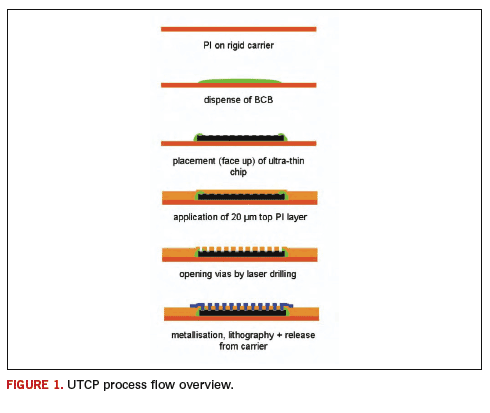
Embedding for Flexible Circuits
Flexible circuit boards can be used to integrate electronics into clothing or onto curved surfaces such as machine parts. On typical flex substrates, only pure electronic assembly is performed on the flip chip components. Embedding of passive or active components in flexible printed circuits is not state of the art. The presence of relatively large rigid components, only on the front and backside of the flex laminate, is an important factor limiting not only the miniaturization, but also the mechanical flexibility of the circuits.Based on the above-mentioned UTCP approach, a technology was worked out for the 3D integration of active devices inside the innerlayers of commercial multilayer flexible circuit boards (FIGURE 2). The UTCP packages serve as interposers: ultra-thin active devices are first integrated as UTCP, which in turn, is embedded inside a standard multilayer flex circuit.
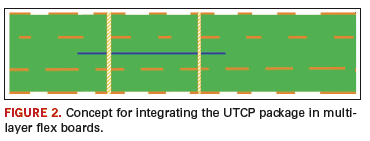
A suitable process flow to integrate small UTCP packages inside large flex laminates has been successfully established at ACB, a Belgian flex manufacturer. UTCP packages are aligned and fixed (by heat tack) on a patterned inner layer of the multilayer substrate, and connection between package and wiring of the PCB or FPCB is achieved by through-hole interconnects.
This embedding concept was first demonstrated with UTCP test packages, indicating that a 3.5 μm metal thickness on the UTCP package is sufficient to ensure good interconnects and that an ENIG metal finish on the UTCP samples will not affect the through-hole plating quality. Daisy chain interconnects between integrated dummy packages and the FPCB were characterized and monitored during reliability investigations. High temperature storage at 150° C (up to 1000 h), hot humidity storage at 85° C/85 relative humidity (up to 1000 h) and thermal cycling between -40° C and +125° C (up to 1000 cycles) did not introduce any failure at the interconnects. The integration process also does not affect the values of the 4PT via resistance of the interconnects on the UTCP package.
Technology Demonstration: Functional ECG
Wearable monitoring systems for health or sport applications often make use of flexible circuit boards. In this way, they can unobtrusively be integrated into clothing or be worn in the form of a ‘band-aid’. An important factor limiting miniaturization and flexibility is typically the presence of relatively large rigid components. For this reason, the UTCP technology for embedding active circuitry into an FPCB is ideally suited for these systems.A prototype ECG/EMG wireless monitoring system (FIGURE 3) was realized using the above-described technology. The prototype measures the heart rate (electrocardiogram or ECG) and muscle activity (electromyogram or EMG). It consists of three integrated circuits: an ultra-lowpower ECG/EMG amplifier circuit, a commercial TI microcontroller with embedded analog-to-digital converter (ADC) and a Nordic 2.4 GHz low-power radio transceiver. Additionally, some supporting passives, a battery, a loop antenna and some electrodes are included.
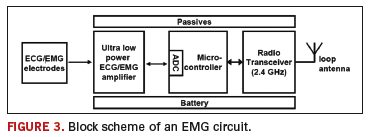
The microcontroller and ADC circuit were embedded inside an FPCB. First, the individual chip was thinned down, starting from the initial die thickness of 300 μm to 25 μm, using a proprietary-developed individual chip thinning process. Secondly, these very thin, functional microcontroller devices were embedded as an ultra-thin-chip package. The UTCP-packaged microcontroller could easily be tested after assembly but before release from its carrier. After testing the UTCP-packaged microcontrollers, they were cut out from the glass substrates, resulting in ± 1 cm² x 1 cm², square UTCP packages. Next, the UTCP-packaged microcontrollers were integrated in the innerlayers of the multilayer flex substrates. Finally, components were assembled on both sides of the flex substrates: SMT components, the IMEC biopotential ASIC and the Nordic radio. These actives were wire bonded on the substrates (Chip-On-Flex, [COF]), after the SMT components were assembled.
The wireless ECG/EMG biopotential prototype (FIGURE 4) with UTCP-packaged and FPCB-embedded microcontroller (FIGURE 5) proved to be completely functional and able to monitor ECG and EMG signals.
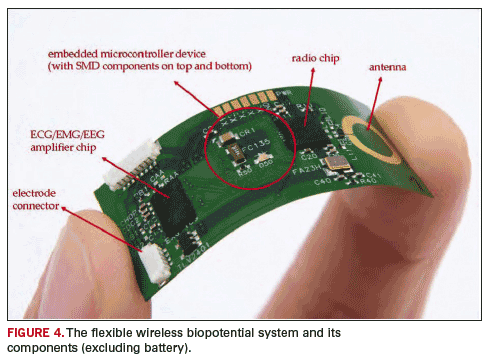
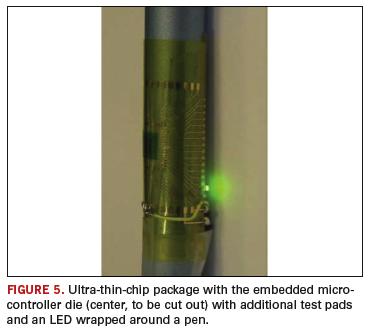
Conclusion
The ultra-thin-chip package (UTCP) technology offers the possibility to integrate functional devices inside flexible multilayer circuit boards. These UTCP interposers provide a contact fan out with more relaxed pitches, allowing for easy testing before integration. Moreover, this fan out eliminates the need for precise placement and ultra-high-density printed circuit boards. The thin, mechanical flexible devices can be laminated inside the adhesive innerlayers of conventional low-cost multilayer substrates, using only standard production processes. PCD&FACKNOWLEDGEMENTS
This research was done in the framework of the FP6 project SHIFT. This publication is intended to report the outcome of the research and the capabilities of the technology developed in the framework of this project.Els Parton is a scientific editor responsible for authoring and editing IMEC’s company technical documents and publications; This email address is being protected from spambots. You need JavaScript enabled to view it.. Wim Christiaens is a technology developer at Ghent University. Jan Vanfleteren is a senior engineer with the IMEC-CMST group and a part time professor at the Ghent University.




